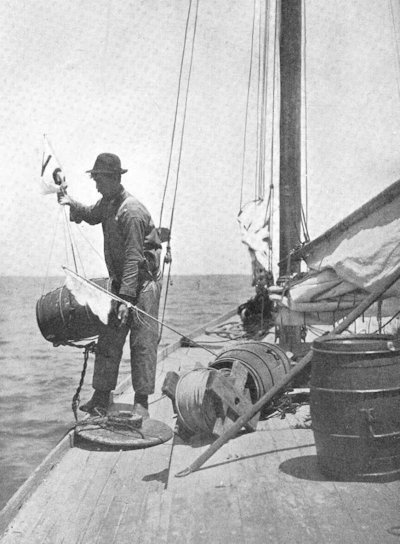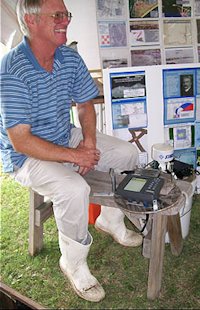First of two parts
ENGELHARD — This summer ground will be broken in northeast Hyde County for a restoration project conceived by unlikely partners—a farmer and environmentalists.
Supporter Spotlight
The farmer hails from a community of avid outdoorsmen and women in one of the most conservative areas of the country, a group that doesn’t generally cotton to environmentalists.
Working alongside him will be restoration staff members from the N.C. Coastal Federation. They all hope to put a whole landscape back in order.
When the last shovelfuls of dense black peat are put into modified dikes and sloughs on Lux Farms, much of the agricultural drainage from 1,400 acres will be removed from Pamlico Sound and redirected into its natural flow through wetlands toward the north.
As future phases move forward, the farmer will be able to store drainage water in irrigation ponds for use in dry times. The installation of flood gates will help protect farm soils from poisonous salt water as the world’s seas rise.
And improvements in water quality in Pamlico Sound will enable conservationists to build low-profile oyster reefs offshore, enhancing local fisheries and helping provide a buffer from storm surges.
Supporter Spotlight
It Began With an Oyster
 A researcher in 1907 drops a buoy on an experimental oyster reef in Pamlico Sound. Photo: Freshwater and Marine Image Bank, Washington University Libraries. |
The story of the landscape-scale restoration work in Hyde County begins, as many tales do, with a remarkably small player: the humble oyster.
In 2004, the federation received a grant from the N.C. Clean Water Management Trust Fund to write a coast-wide blueprint for resuscitating the state’s badly depleted oyster population. The federation targeted oysters for a reason: These energetic filter feeders remove copious amounts of pollution from estuaries. In a few hours a single oyster can clean a 10-gallon tank of muddy water.
But the state’s once-great oyster reefs have been decimated by a combination of overfishing, disease and habitat destruction. The grant required the federation to convene a group of experts to figure out how the oyster population could be brought back.
The federation established work groups on the north, central and southern coasts. The northern group’s assignment was complicated by the sheer size of the region’s waters, including Pamlico Sound.
Picture a dozen scientists, conservationists and fisheries biologists in a room, all talking about the research they’ve done on oysters and trying to figure out what more is needed. This writer was there and was impressed by the brain power. Trouble was, no one seemed to have a game plan for moving forward.
Previous work by researchers, the Nature Conservancy and the N.C. Division of Marine Fisheries had found that oyster larvae, or spat, would attach to chunks of limestone stacked in underwater piles. Limestone reefs were being built to replace historic oyster rocks that had been covered by sediment or destroyed by oyster dredges.
Building rock piles in the sound was expensive, and oyster spat must depend on currents to carry them to suitable habitat. Unless new reefs were built in places where currents would deposit spat, the work would be wasted.
But how could the group figure out the seasonal track of subsurface currents in Pamlico Sound? Such detailed flow studies had never been done.
An answer came not from the academic brain trust but from an Ocracoke waterman named Gene Ballance, who had painstakingly reconstructed maps of oyster reefs drawn in the 1880s drawn by Navy researcher Francis Winslow. Ballance is an Ocracoke native with thick glasses, a wide, friendly grin and an abiding love for oysters. He views the fate of the oyster and the commercial fishing industry as intertwined, and he is not willing to let go of either one.
His reconstruction of the Winslow maps showed a necklace of oyster reefs off the Hyde County mainland. If currents had carried oyster spat to those locations in the 1880s, it was likely they would still do so.
 Gene Ballance |
What’s more, the historic reefs lay in a region that had been shown by a Nature Conservancy study to have some of the highest biodiversity in southeast U.S. waters. New oyster reefs would provide habitat for other estuarine creatures—as well as knocking down storm waves that were causing severe erosion along the Hyde mainland.
There was just one problem. Stormwater from agricultural fields carried sediment, bacteria and plumes of tannic, overly fresh water into the sound just off Hyde County, ruining the waters for oysters.
A ‘Natural Partnership’
Wilson Daughtry and his wife, Debby, own Alligator River Growers. He is known in Hyde County as the go-to man for onions. In a county of soybean, corn and cotton fields, the Daughtries have made a name for themselves growing high-value crops like broccoli and the sweet onions that thrive in the black peat soils. Besides farming his own land, Wilson manages the adjacent Lux Farms property for several partners.
The federation in 2005 convened a group to look for wetland restoration projects that could help clean up the local waters for oyster restoration. Daughtry was one of the farmers invited to attend. The goal of the group was to find sites where water from ditches and canals could be diverted into wetlands, removing some of the runoff that poured into Pamlico Sound.
Daughtry and Mac Gibbs, director of the county’s agricultural extension service, had been collaborating on ideas for what were called tail water projects, in which drainage could be held in low-lying farm fields instead of being pumped to the sound. The water could be used for irrigation, saving money on pumping expense. “When we heard that the Coastal Federation was interested in holding back water to improve the sound for oysters,” Gibbs said, “it seemed like a natural partnership.”
The federation had something the farmers lacked: a working knowledge of how to write grants and experience with hydrologic restoration at North River Farms in Carteret County.
Daughtry is a respected farmer with a sense of humor. One afternoon when the federation staff stopped by his farm office to chat (a folksy custom that’s become an art form in Hyde County), he casually pulled out an infrared satellite image of Lux Farms. “Take a look at that,” he said.
The image showed a wide swath of red running through the middle of the farm—low, wet land, most of it grown up in the unusual bog known as pocosin. An excited expression spread across the face of Christine Miller, an assistant director at the federation. “Is that—is that an old slough going through the middle of the farm?” she asked.
Wilson rubbed his chin. “Some people say it is.”
The image showed that water from the western end of Lux Farms had historically drained north toward what is now the Alligator River National Wildlife Refuge. If the slough could be restored, much of Lux Farm’s drainage could be removed from Pamlico Sound.
They were looking at a project the size of which had seldom been done—and that, they knew, had the potential to become a national model for restoration.
Tuesday: A plan takes shape







